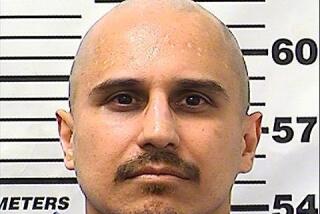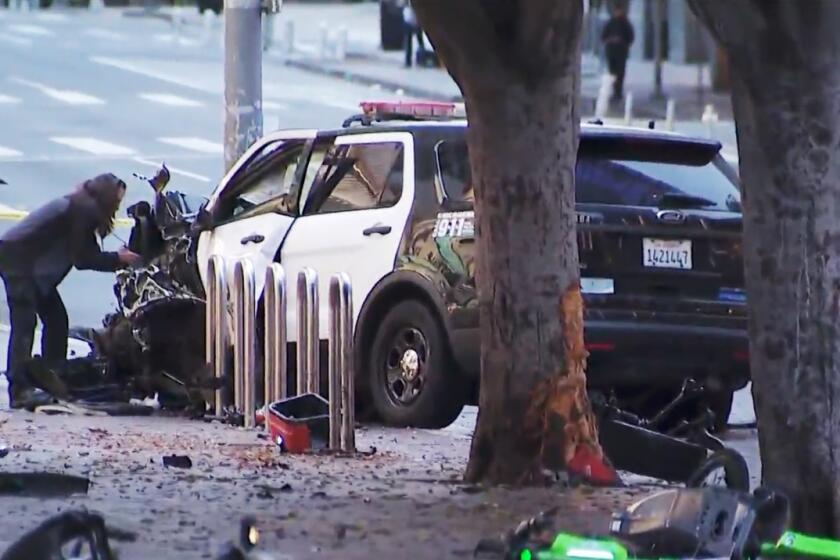COVER STORY : Pushcart Power : Frustrated by Police Crackdowns, Vendors United to Legalize Their Meager Livelihoods.Next Month, Their 6-Year Struggle Comes Before the City Council.
DORA ALICIA ALARCON WAS angry, frustrated and frightened.
The street vendor had just spent a night in jail. Her crime: selling mangoes.
“All I wanted to do was help take care of my children,” said Alarcon, a mother of five and a Salvadoran immigrant. “I just wanted to make an honest living.”
Her arrest in early 1987 for violating a city law banning street vending led her to join about 50 vendors and activists who had begun meeting at a Pico-Union church to figure out what to do about the widespread police crackdowns.
Though the vendors did not know it at the time, those early meetings launched a movement that has culminated in a proposed ordinance to legalize street vending in designated areas of the city.
Along the way, the vendors learned about the down side of working with government. It took a task force more than a year to draft recommendations that vending be legalized. Many vendors dropped out of the effort because progress came so slowly. And the law that may go on the books would end up being costly for vendors and likely to initially legalize vending for only about 10% of them.
But as the ordinance comes up for a City Council committee hearing next month the vendors are savoring a sense of accomplishment and the knowledge that there is power in numbers. At a recent City Council meeting, about 500 vendors turned out in support of the ordinance, giving up a day’s income to do so.
“I think the vendors realize that City Hall has a lot of power over their destiny and that it’s important that they let us know what their needs are,” said Councilman Mike Hernandez, whose 1st District is home to many of the city’s estimated 5,000 street vendors. “And I think that’s what this movement has done.”
The influx of street vendors accompanied the unprecedented wave of immigration from Latin America to Los Angeles during the 1980s. The immigrants brought their traditions with them, including the generations-old practice of flocking to churches, town plazas and markets to hawk their wares as street vendors.
Angelica Tenorio, 48, was an immigrant of that era. A vendor in her native El Salvador, she came to Los Angeles five years ago and was surprised when she found out that vending could land her in jail.
“We are not selling anything illegal--just food,” said Tenorio, who sells peeled mangoes sprinkled with chili powder and fried banana chips called platanillos near Western Avenue in the Mid-City area.
The number of vendors eventually swelled, and their colorful umbrellas and carts sprang up throughout the city. There was just one problem: Street vending was, and still is, illegal in Los Angeles. Vending is a misdemeanor punishable by up to six months in jail and a $1,000 fine.
That point is frequently noted by some business owners, who view the vendors as unfair competition and complain that they crowd the streets and create unsanitary conditions.
“The mess left by them is horrendous,” said Norm Langer, owner of Langer’s Delicatessen in Westlake. Langer, who opposes legalized street vending, said he has spent as much as $3,000 a year to clean up discarded mango peelings and grease and mayonnaise stains from the sidewalk in front of his 43-year-old restaurant.
In response to complaints from business owners such as Langer, police began their crackdowns. The police also alleged that some vendors posed as lookouts for drug dealers in areas such as MacArthur Park, a charge that vendors and their advocates denied.
Vendors were run out of the Downtown area, except for Olvera Street, where the Catholic Church declared a safe zone. Vendors there said the crackdowns eased. But in the rest of Downtown, more than 3,600 vending arrests were made from late 1986 to the first half of 1990, according to a City Council report.
Those involved in the vendor meetings during 1987 recall how the immigrants were confused by a culture and a government bureaucracy they knew little about. Many did not understand why vending was illegal.
“They were scared and wanted to do something, but they had no idea how to get things done,” said organizer Sussana Brinnon, who helped arrange the meetings. “They were a community that didn’t know anybody.”
Brinnon was among several women activists and attorneys who would play key roles in shepherding the fledgling vendor group. Although the women were mainly involved with the larger issue of opposing U.S. intervention in Central America, they were drawn to the vendors and their children.
“It was one thing to go out and demonstrate at the Federal Building, but it was a totally different thing to meet the people who were living the consequences of U.S. policy,” said activist Margaret Arnold. “It really put a human face on the political work we were doing.”
During its first year, the vendors group was beset by disorganization, a lack of leadership and a general feeling that nothing could be done. Members recall that dozens of frustrated vendors quit the group, only to be replaced by new recruits who had heard on the street that an organization had formed to help counter the police crackdowns.
“So many came and went,” said Marta Armenta. “They never believed anything would happen.”
Meanwhile, the crackdowns continued, with many vendors alleging that they were punched and kicked by police. “We were bombarded by complaint after complaint, primarily by women who were suffering harassment by the police,” said attorney Madeline Janis-Aparicio, who was asked to help with the complaints.
Police denied that any excessive force was used. Capt. Francisco Pegueros said officers had better things to do than arrest women for selling fruit, especially in crime-ridden areas of Central Los Angeles. “We certainly understand the concerns of business owners. But in the grand scheme of things, there are higher priorities,” he said.
By 1989, the vendors movement started to gain momentum as it became more organized and other groups and individuals assisted. The group, which had grown to about 200 members, had begun calling itself the Asociacion de Vendedores Ambulantes, or Street Vendors Assn.
It was meeting biweekly in Pico-Union at the Central American Refugee Center, which supplied a part-time bilingual organizer to help the members network with the community. Members elected a seven-person board and wrote bylaws defining the group’s mission.
“For us, this wasn’t about politics,” said Alarcon, who was the association’s president during that period and emerged as the main spokeswoman from the ranks of the vendors. “We were fighting so that we could make an honest living to help our children. We wanted them to have a better life than we have.”
Alarcon sends part of her earnings to her children in El Salvador. On a good day, she says, she makes about $35.
Meanwhile, Janis-Aparicio and other attorneys considered various legal strategies to help the vendors. They decided the best route was to push for a city ordinance that would legalize street vending.
Activist Gilda Haas, a former aide to then-Councilman Mike Woo, suggested that the group approach Woo for help.
In an interview, Woo said he decided to help because he thought it was unusual that the city outlawed street vending, which he saw as adding vitality to neighborhoods. “It was an issue of whether we in Los Angeles should do more to encourage and revitalize street life,” he said.
In July, 1989, Woo formed the Street Vending Task Force, which included vendors, police, city officials, activists and members of business groups. The task force would spend the next 15 months studying street vending in Los Angeles, the only major city in the United States that outlaws the practice.
While the task force met, police and officers on horseback began a monthlong crackdown against vendors and drug dealers in MacArthur Park that resulted in several hundred arrests in June, 1990.
“They just wanted to chase us away,” said Raquel Correa, 37, who worked the area at the time and still evades police today while she sells hot dogs and sodas near Alvarado and 7th streets. She relies on lookouts to warn her when officers approach and hides her cart in the doorway of an apartment building until they leave.
In October, 1990, the city task force issued its report that recommended legalizing street vending within designated commercial areas of the city. “Attempting to drive these (vendors) out of business through criminal police enforcement has not proven to be an effective means of addressing a growing problem,” the report concluded.
Task force members said the group was initially divided between those who supported vending citywide and others who were opposed altogether. But the group concluded that street vending was not going to go away and that the best compromise was to regulate it, participants said.
“We were so happy. We thought we would no longer have to fight this battle,” said Alarcon, a member of the task force.
She was wrong.
For the next 2 1/2 years, the task force proposals would be caught up in City Hall bureaucracy and politics. They were debated by City Council committees while representatives of the task force, council members and the city attorney’s office worked on the language of the ordinance.
Meanwhile the vendors association, which had come of age during the years of struggle, conducted its own lobbying campaign. Supporters showed up in force during council hearings and held “street theaters” outside City Hall during which vendors and their children would simulate being arrested by the police. The association also collected 5,000 postcards signed by supporters that were sent to City Council members.
Then last month, the council was scheduled to take a final vote on the proposed ordinance. In a show of support, more than 500 vendors filled the council chambers and spilled out into the hallway.
For many, such as 68-year-old Maria Antonia Hernandez, attending the meeting meant losing hard-earned money. She said she sometimes makes as little as $10 a day selling vegetables, but “it’s important to go because we have to let the council know we care.”
However, the vote that day was postponed and the measure was sent back to the Public Works Committee because some council members wanted task force members to fine-tune details of the ordinance. The committee will consider the ordinance next month.
Committee Chairwoman Rita Walters “has some serious questions about the plan,” including concerns about residents who might not want vendors in residential areas next to commercial zones, said her spokesman, Howard Gantman. He said last week she was still reviewing the ordinance and had not decided whether to support it.
Councilman Hernandez said he is confident that the ordinance will become law.
A spokesman for Mayor Richard Riordan said he generally supports the idea of vending in designated districts as long as businesses in the area are not adversely affected.
Under the proposed ordinance, vending would be allowed in designated commercial areas. Those areas would be determined by an application process that includes vendors gathering signatures from the neighborhood’s residents and a public hearing before the city’s Board of Public Works, which would decide the matter. The City Council member representing the affected area would also review the request and make recommendations.
The association wants to apply for vending districts on the Eastside, in Westlake/Pico-Union, Hollywood and on Olvera Street.
“There are thousands of us, and we are not going to go away,” Tenorio said. “They might as well make (vending) legal.”
The four proposed districts would only accommodate about 500 vendors, or about 10% of the city’s vendor population, the association said. Vendors and their supporters say they will eventually push for more districts, although they have no timetable.
The proposed ordinance also would be costly for the vendors. The annual vendors license fee would be $439, insurance is estimated at $150 per year, and food vendors would be required to buy $1,500 carts approved by the health department.
But regardless of the costs or what the council ultimately decides, the vendors say they are better off for having launched their effort. For one thing, the vendors association has raised $53,000 from various foundations, which has been used primarily to make business loans to its members. The association members say they have been able to raise awareness about an issue that received scant attention during those difficult days of 1987.
“We have learned that together we have power,” said Alarcon. “We have learned that we have rights just like everyone else.”
More to Read
Start your day right
Sign up for Essential California for news, features and recommendations from the L.A. Times and beyond in your inbox six days a week.
You may occasionally receive promotional content from the Los Angeles Times.







